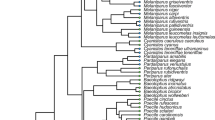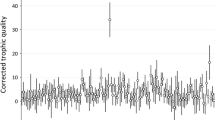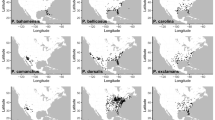Abstract
The niche variation hypothesis predicts a direct relationship between intraspecific variability in feeding ecology and the variability of the morphological traits related to feeding behaviour. The following study tests this prediction by measuring in captivity the seed size preferences and the morphology of 9–11 individuals of seven specialized granivorous bird species. The average seed size preferences of these birds have previously been shown to be related to components of bill size. The ranges of seed sizes selected were related to the mean bill sizes of birds in a way that paralleled the patterns found when analysing average values. Bill and body size variability were not related, however, to the range of seed preferences after controlling for the significant mean-variance relationship showed by morphological traits. Thus, results do not support the niche variation hypothesis. the significant effect of average bill size on diet variability was consistent with the direct relationship between bird size and ecological plasticity expected on the basis of the shape of the family of functions relating seed size and seed profitability for different-sized birds. These findings suggest morphological mechanisms for ecological plasticity whose generality and evolutionary significance merit further research.
Similar content being viewed by others
References
Benkman CW (1991) Predation, seed size partitioning and the evolution of body size in seed-eating finches. Evol Ecol 5: 118–127
Benkman CW, Pulliam HR (1988) The comparative feeding rates of North American sparrows and finches. Ecology 69: 1195–1199
Bock WJ (1966) An approach to the functional analysis of bill shape. Auk 83:10–51
Carlson A (1992) Body size, prey handling efficiency and choice of diet in three coniferous forest tits (Paridae). Biol J Linn Soc 46:299–308
Carrascal LM, Moreno E, Tellería JL (1990) Ecomorphological relationships in a group of insectivorous birds of temperate forests in winter. Holarct Ecol 13:105–111
Díaz M (1990) Interspecific patterns of seed selection among granivorous passerines: effects of seed size, seed nutritive value and bird morphology. Ibis 132:467–476
Endler JA (1991) Interactions between predators and prey. In: Krebs JR, Davies NB (eds), Behavioural ecology: an evolutionary approach, 3rd edn. Blackwell, Oxford, pp 169–176
Felsenstein J (1985) Phylogenies and the comparative method. Am Nat 125:1–15
Futuyma DJ, Moreno G (1988) The evolution of ecological specialization. Annu Rev Ecol Syst 19:207–233
Garland T Jr, Harvey PH, Ives AR (1992) Procedures for the analysis of comparative data using phylogenetically independent contrasts. Syst Biol 41:18–32
Glück EE (1985) Seed preference and energy intake of Goldfinches Carduelis carduelis in the breeding season. Ibis 127:421–429
Gosler AG (1987) Pattern and process in the bill morphology of the Great Tit Parus major. Ibis 129:451–476
Grant PR (1986) Ecology and evolution of Darwin's finches. Princeton University Press, Princeton
Green RH (1974) Multivariate niche analysis with temporally varying environmental factors. Ecology 55:73–83
Greenberg R (1990) Ecological plasticity, neophobia, and resource use in birds. Stud Avian Biol 13:431–437
Greig-Smith P, Wilson MF (1985) Influences of seed size, nutrient composition and phenolic content on the preferences of bull-finches feeding on ash trees. Oikos 44:47–54
Harvey PH, Pagel MD (1991) The comparative method in evolutionary biology. Oxford University Press, Oxford
Hespenheide HA (1975) Prey characteristics and predator niche width. In: Cody ML, Diamond JA (eds) Ecology and evolution of communities. Belknap Press, Cambridge, Mass, pp 155–180
Hurlbert SH (1984) Pseudoreplication and the design of ecological field experiments. Ecol Monogr 54:187–211
Inman AJ, Lefebvre L, Giraldeau LA (1987) Individual diet differences in feral pigeons: evidence for resource partitioning. Anim Behav 35:1902–1903
Kear J (1962) Food selection in finches with special reference to interspecific differences. Proc Zool Soc Lond 138:163–204
Martins EP, Garland T Jr (1991) Phylogenetic analyses of the correlated evolution of continuous characters: a simulation study. Evolution 45:534–557
Ministerio de Agricultura (1984) Tablas de composición de primeras materias para nutrición animal. Ministerio de Agricultura, Madrid
Morse DH (1980) Behavioural mechanisms in ecology. Harvard University Press, Cambridge, Mass
Newton I (1967) The adaptative radiation and feeding ecology of some British finches. Ibis 109:33–98
Osenberg CW, Mittelbach GG (1989) Effects of body size on the predator-prey interaction between pumpkinseed sunfish and gastropods. Ecol Monogr 59:405–432
Partridge L (1976) Individual differences in feeding efficiencies and feeding preferences of captive Great Tits. Anim Behav 24:230–240
Peters RH (1983) The ecological implications of body size. Cambridge University Press, Cambridge
Polis GA (1984) Age structure component of niche width and intraspecific resource partitioning: can age groups function as ecological species? Am Nat 123:541–564
Price T (1987) Diet variation in a population of Darwin's finches. Ecology 68:1015–1028
Pulliam HR (1985) Foraging efficiency, resource partitioning, and the coexistence of sparrow species. Ecology 66:1829–1836
Pyke GH, Pulliam HR, Charnov EL (1977) Optimal foraging: a selective review of theory and tests. Q Rev Biol 52:137–154
Ritchie ME (1988) Individual variation in the ability of Columbian ground squirrels to select an optimal diet. Evol Ecol 2: 232–252
Rothstein SI (1973) The niche-variation model—is it valid? Am Nat 107:598–620
Roughgarden J (1972) Evolution of niche width. Am Nat 106: 683–718
Selander RK (1966) Sexual dimorphism and differential niche utilization in birds. Condor 68:113–151
Sherry TW (1990) When are birds dietarily specialized? Distinguishing ecological from evolutionary approaches. Stud Avian Biol 13:337–352
Sibley CG, Ahlquist JE (1991) Phylogeny and classification of birds: a study in molecular evolution. Yale University Press, New Haven
Smith NM, Sweatman HPA (1976) Feeding habits and morphological variation in Cocos finches. Condor 78:244–248
Smith TB (1987) Bill size polymorphism and intraspecific niche utilization in an African finch. Nature 329:717–719
Sokal RR, Rohlf FJ (1981) Biometry, 2nd edn. Freeman, San Francisco
Van Valen L (1965) Morphological variation and width of ecological niche. Am Nat 99:377–389
Van Valen L, Grant PR (1970) Variation and niche width reexamined. Am Nat 104:589–590
Wainwright PC (1988) Morphology and ecology: functional basis of feeding constraints in Caribbean labrid fishes. Ecology 69:635–645
Werner EE (1974) The fish size, handling time relation in several sunfishes and some implications. J Fish Res Board Can 31:1531–1536
West L (1988) Prey selection by the tropical snail Thais melones: a study of interindividual variation. Ecology 69:1839–1854
West-Eberhard MJ (1989) Phenotypic plasticity and the origins of diversity. Ann Rev Ecol Syst 20:249–278
Willson MF (1971) Seed selection in some North American finches. Condor 73:415–429
Willson MF, Karr JR, Roth RR (1975) Ecological aspects of avian bill-size variation. Wilson Bull 87:32–44
Wilson DS (1975) The adequacy of body size as a niche difference. Am Nat 109:769–784
Wu WT (1975) Tabla de composición de alimentos para uso en América Latina. Interamericana, Méjico
Author information
Authors and Affiliations
Rights and permissions
About this article
Cite this article
Díaz, M. Variability in seed size selection by granivorous passerines: effects of bird size, bird size variability, and ecological plasticity. Oecologia 99, 1–6 (1994). https://doi.org/10.1007/BF00317076
Received:
Accepted:
Issue Date:
DOI: https://doi.org/10.1007/BF00317076




